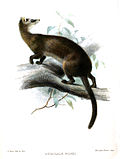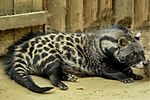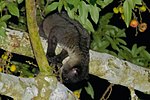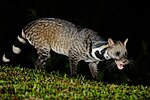The brown palm civet (Paradoxurus jerdoni), also called the Jerdon's palm civet, is a viverrid endemic to the Western Ghats of India. The scientific name...
9 KB (1,019 words) - 17:24, 7 July 2024
The Sulawesi palm civet (Macrogalidia musschenbroekii), also known as Sulawesi civet, musang and brown palm civet is a little-known viverrid endemic to...
6 KB (708 words) - 23:52, 18 July 2024
Sulawesi palm civet (Macrogalidia musschenbroekii) Masked palm civet (Paguma larvata) Asian palm civet (Paradoxurus hermaphroditus) Brown palm civet (Paradoxurus...
770 bytes (115 words) - 22:53, 17 January 2024
Paradoxurus (redirect from Southern palm civet)
head and body. The three species are the Asian palm civet, the Golden palm civet, and the Brown palm civet. Paradoxurus species have a broad head, a narrow...
7 KB (710 words) - 07:52, 20 May 2024
who described a fulvous brown palm civet from the mountains of Sri Lanka, which he considered a variety of the golden palm civet. Paradoxurus stenocephalus...
9 KB (914 words) - 06:57, 11 August 2024
The masked palm civet (Paguma larvata), also called the gem-faced civet or Himalayan palm civet, is a viverrid species native to the Indian subcontinent...
17 KB (1,745 words) - 15:27, 10 July 2024
listed as least concern on the IUCN Red List. The African palm civet is grey to dark brown with dark spots on the back. It has short legs, small ears...
15 KB (1,717 words) - 15:42, 1 August 2024
The banded palm civet (Hemigalus derbyanus), also called the banded civet, is a viverrid native to Indomalaya. They primarily inhabit lowland conifer habitat...
20 KB (2,097 words) - 17:21, 7 July 2024
The Asian palm civet (Paradoxurus hermaphroditus), also called common palm civet, toddy cat and musang, is a viverrid native to South and Southeast Asia...
20 KB (2,214 words) - 06:12, 23 June 2024
Hose's palm civet (Diplogale hosei), also known as Hose's civet, is a viverrid species endemic to the island of Borneo. It is listed on the IUCN Red List...
14 KB (1,568 words) - 05:59, 4 March 2024
Owston's palm civet (Chrotogale owstoni) is a viverrid native to Vietnam, Laos and a very small portion of southern China, in three counties located in...
10 KB (1,221 words) - 19:56, 30 June 2024
Viverridae. It is also used to refer to the African palm civet and the Malagasy civet. The African palm civet (Nandinia binotata) is genetically distinct and...
14 KB (1,582 words) - 09:28, 17 September 2024
The small-toothed palm civet (Arctogalidia trivirgata), also known as the three-striped palm civet, is a viverrid native to dense forests of Southeast...
5 KB (471 words) - 05:56, 4 March 2024
The African civet (Civettictis civetta) is a large viverrid native to sub-Saharan Africa, where it is considered common and widely distributed in woodlands...
28 KB (2,946 words) - 10:25, 18 August 2024
The large Indian civet (Viverra zibetha) is a viverrid native to South and Southeast Asia. It is listed as Least Concern on the IUCN Red List. The global...
9 KB (1,023 words) - 02:45, 18 March 2024
The small Indian civet (Viverricula indica) is a civet native to South and Southeast Asia. It is listed as Least Concern on the IUCN Red List because...
28 KB (2,787 words) - 16:03, 10 July 2024
closely related to Madagascar carnivores, including the fossa and Malagasy civet. Galidiinae is considered a subfamily of Eupleridae. Phylogenetic research...
39 KB (2,741 words) - 21:17, 4 September 2024
but is a member of the Eupleridae. The African palm civet (Nandinia binotata) resembles the civets of the Viverridae, but is genetically distinct and...
38 KB (2,338 words) - 11:15, 5 August 2024
The Malayan civet (Viverra tangalunga), also known as the Malay civet and Oriental civet, is a viverrid native to the Malay Peninsula and the islands of...
9 KB (975 words) - 05:50, 4 March 2024
records of traditional-medicine use of the plant. Paradoxurus jerdoni (Brown palm civet) consumes parts of the tree. The species has an accepted variety, Elaeocarpus...
12 KB (1,121 words) - 20:17, 16 March 2024
properties through convergent evolution, including members of the mongoose, civet, weasel, cat, and bear families.) The coati snout is long and somewhat pig-like...
21 KB (2,455 words) - 00:28, 8 September 2024
The otter civet (Cynogale bennettii) is a semiaquatic viverrid native to Thailand, Malaysia, Indonesia and Brunei. It is believed to be undergoing severe...
7 KB (639 words) - 05:49, 15 April 2024
The brown hyena (Parahyaena brunnea), also called strandwolf, is a species of hyena found in Namibia, Botswana, western and southern Zimbabwe, southern...
19 KB (2,027 words) - 03:44, 16 September 2024
Different species of skunk vary in appearance from black-and-white to brown, cream or ginger colored, but all have warning coloration. While related...
27 KB (3,144 words) - 13:40, 11 September 2024
Aardwolf (redirect from Civet hyena)
termite-eating hyena and civet hyena, based on its habit of secreting substances from its anal gland, a characteristic shared with the African civet. Unlike many...
25 KB (2,848 words) - 11:34, 19 September 2024
the Malagasy species being in their own family Eupleridae. The African palm civet is a basal cat-like carnivoran. The linsang is more closely related to...
46 KB (4,423 words) - 19:24, 16 September 2024
sizes and silhouette. The Malagasy civet was to be placed in the subfamily Hemigalinae with the banded palm civets and then in its own subfamily, Fossinae...
10 KB (1,053 words) - 11:13, 13 April 2024
Oliver (2012-11-19). "World's most expensive coffee tainted by 'horrific' civet abuse". The Guardian. ISSN 0261-3077. Retrieved 2024-04-12. BKSDA Sulawesi...
34 KB (3,740 words) - 01:09, 5 September 2024
Masked palm civet (Paguma larvata) Paradoxurus Asian palm civet (P. hermaphroditus) Brown palm civet (P. jerdoni) Golden palm civet (P. zeylonensis)...
40 KB (4,142 words) - 05:39, 14 August 2024
The brown bear (Ursus arctos) is a large bear native to Eurasia and North America. It is one of the largest land carnivorans, rivaled in size only by...
130 KB (14,628 words) - 18:14, 17 September 2024





























